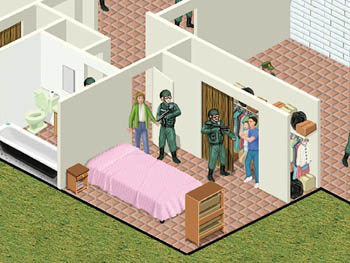![[Metroactive Arts]](/arts/gifs/art468.gif)
[ Arts Index | Silicon Valley | Metroactive Home | Archives ]
It's Only a Game
'Fictional Worlds' show at Stanford traces development of narrative in computer gaming
By Michael S. Gant
IT'S ONLY been 30 years or so, and already the early versions of computer games are starting to look extremely quaint. The vintage game boxes on display at Stanford's Cantor Center for the Arts reek of eight-tracks and bell bottoms. Some of the games might as well be untranslatable tablets from Mesopotamia. The 1981 role-playing adventure Upper Reaches of Apshai was designed to run on a Radio Shack TRS-80; who's got one of those in working order? (Well, check out www.trs-80.com--computer archaeologist Ira Goldklang does.)
The show comes with an ambitious title, "Fictional Worlds, Virtual Experiences: Storytelling and Computer Games." No doubt, as the press release declares, "Computer games are among the newest vehicles for telling stories ... and represent an emerging narrative form." Setting aside simple games like Pong, the narrative impulse is a given. Most games, from Chutes and Ladders to Monopoly, employ some kind of narrative structure, and they're interactive--solo Monopoly is no fun at all, unless you're Bill Gates.
What makes the computer game narrative new lies in the nature of that interactivity. Players are either competing against some rudimentary simulacrum of artificial intelligence or they are competing across networks that allow for large-scale electronic social constructions.
In one room of the exhibit, it's possible to play some old-fashioned computer games. Zork I, circa 1980, is an all-text exercise in which the gamer proceeds by issuing simple orders ("Go north," "Go south") until the computer stops responding, "You can't do that" or "I don't understand." Eventually, the player, like a blind man relying on the kindness of an obtuse stranger, is led in search of a treasure through a landscape that includes a canyon and a rainbow (and that's as far as I got).
Visitors may also try the much more complex Bladur's Gate II: Shadows of Amn (2000), which requires the player to make a raft of choices about the backstories and attributes of the game's characters before beginning--in essence, shifting the narrative burden to the user.
Grander still is Star Wars Galaxies, an online role-playing environment that links thousands of users in an evolving universe based on the movie series. Gamers can adopt a variety of species and professions in a vast battle of good vs. evil. The game boasts, according to the official website, "natural A.I. behaviors, including herding, stalking and lair defending," which sounds a bit too much like real life. Scenes from the game are projected on one wall of a darkened room, with somewhat jagged, distended aliens moving through a stark, rectilinear background. The images are slightly hypnotic, basically meaningless without reading the lengthy explanation label.
Which raises the other question the exhibit (and the ongoing They Got Game Project at Stanford) is working at: How does an art museum display a narrative that makes sense of the evolution of computer gaming? The old game boxes are amusing memory jogs, but they tell us more about the state of commercial graphics in the 1980s than they do about the development of gaming theory. A few pages of typescript source code for the 1978 game Adventure convey virtually no information at all. More intriguing is the timeline of game history presented in computerized form.
Surprisingly, though, the best part "Fictional Worlds, Virtual Experiences" isn't an artifact, but an artistic interpretation. In his "screen shots," artist John Haddock uses the isometric perspective of computer graphics to re-create crucial events--the shooting of Lee Harvey Oswald, the tank in Tiananmen Square--as pastel-colored schematics. The narrative of the computer game flows into the narrative of history, dissolving the border between make-believe and make-real.
[ Silicon Valley | Metroactive Home | Archives ]
Copyright © Metro Publishing Inc. Metroactive is affiliated with the Boulevards Network.
For more information about the San Jose/Silicon Valley area, visit sanjose.com.
![]()

The Adventures of Elian: In his imaginative screen shots, John Haddock re-creates memorable headline moments as images from computer games (see whitelead.com/jrh/ for details).
Fictional Worlds, Virtual Experiences runs through March 28 at the Cantor Arts Center, Stanford University. On Feb. 6, Stanford hosts "Story Engines: A Public Program on Storytelling and Computer Games," 9am-5pm. (650.725.6788)
Send a letter to the editor about this story to letters@metronews.com.
From the December 25-31, 2003 issue of Metro, Silicon Valley's Weekly Newspaper.